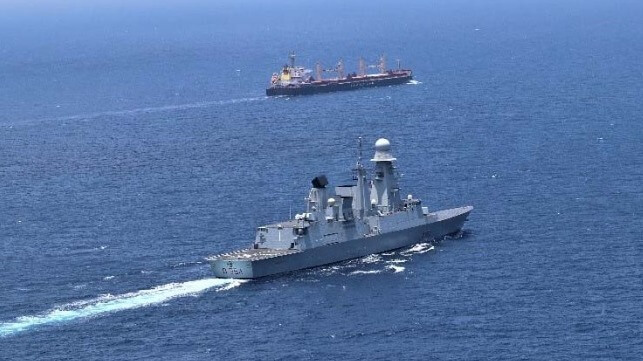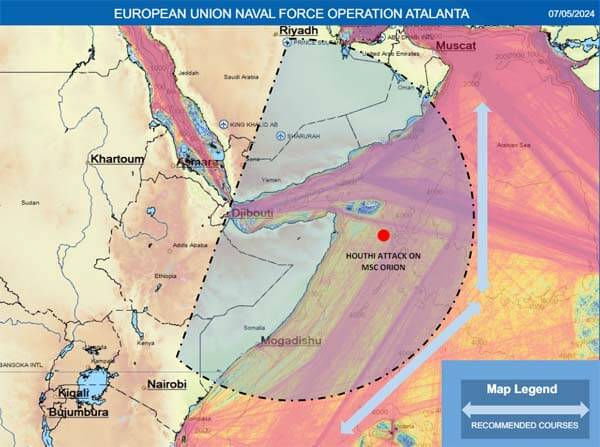WARZONE
EU Advises to Give Wide Berth and Zig-Zagging After Houthi Escalations

As the Red Sea security crisis and the Houthi efforts pass the 150-day mark, the EU security operation issued a new advisory to ships telling them to steer further to sea and take other evasive actions. EUNAVFOR Aspides is telling ships to “maintain a heightened state of vigilance in light of the recent escalation of Houthi attacks using drones in the Indian Ocean.”
The latest advisory is in response to the news that the Houthi targeted the MSC Orion (158,000 dwt) approximately 200 nautical miles southeast of Socotra Island. The attack took place overnight on April 26 but was only confirmed days later with the master of the ship reporting it sustained some minor damage from a drone. The Houthi had previously threatened to disrupt shipping further offshore a fact that the MSC Orion attack confirmed.
“Establish an alternate sea route no less than 150 nautical miles east of the current traffic routes,” EUNAVFOR Aspides is suggesting for shipping in the Indian Ocean. Shipping lines have already noted the added mileage with Maersk and Hapag-Lloyd reporting they had adopted this policy despite the added distance and additional fuel consumption.
The advisory is also reverting to tactics seen in World War I and World War II with ships again being advised “to implement random alterations in course and speed.” In World War II it was called rig-zagging and standard operating procedure for North Atlantic convoys to reduce the threat from submarines.
The third suggestion offered by EUNAVFOR is “a more restrictive AIS policy to minimize positional exposure.” Going dark by turning off AIS signals is already been widely adopted by ships in the region although some had also tried posting messages saying they had no affiliation with Israel, were Chinese crewed, or alike in an attempt to prevent targeting.

EUNAVFOR suggested widening the diversions based on the escalations by the Houthi (EUNAVFOR Aspides)
These steps come as the European and U.S. efforts continue to protect shipping and prevent the Houthi attacks. EUNAVFOR Aspides reports since being established in February it has already completed 100 close protection efforts providing safe transit for merchant vessels.
U.S. Central Command continues to report downing Houthi missiles and drones with the last interception happening early on May 12. EUNAVFOR Aspides’ tracking report shows a total of 157 incidents since November 2023, while the Maritime Security Center Horn of Africa (MSCHOA) calculates 132 attacks on ships, although most have not hit or caused significant damage.
“If the objective is to engage and neutralize aerial attacks from the Houthis once they have indeed been launched, the naval presence is fairly successful,” commented well-known analyst Lars Jensen,
CEO of Vespucci Maritime, in a commentary at the end of last week. “However, from the perspective of reducing the risk of attacks from the Houthis, there has been no progress. As the data clearly shows, the amount of attacks has been steadily increasing despite the military presence.”
EUNAVFOR Aspides is highlighting today that the HNLMS Karel Doorman of the Royal Netherlands Navy, a multi-function support ship designed among other things for amphibious operations, joined the ships deployed in the Red Sea region. She arrived after German, Danish, and Belgian warships did a tour of duty and left the region.
UK Ambassador Barbara Woodward speaking today at the UN Security Council highlighted a "notable surge in vessels that have entered Houthi-controlled ports" which the UK contends are not reporting to UN Verification and Inspection Mechanism for Yemen, which has been operational since 2016. In today's comments, the ambassador asserted that since October 2023, reported violations could equate to as much as 500 truckloads of un-inspected material entering Hodeidah. The UK called for vessels to comply with inspections.
No comments:
Post a Comment